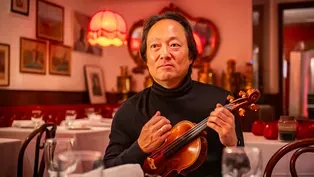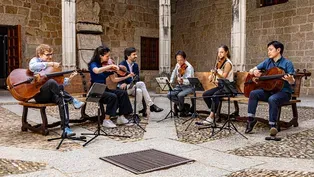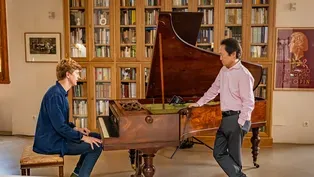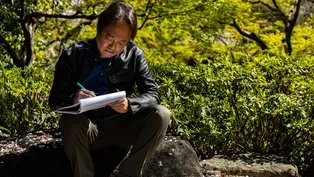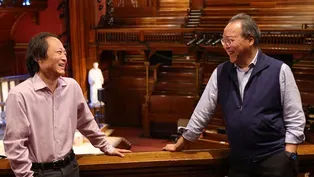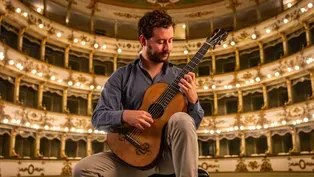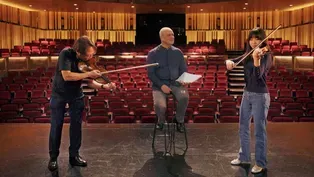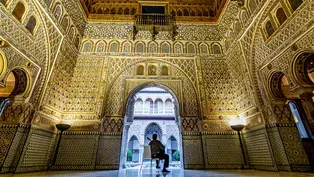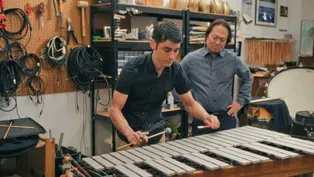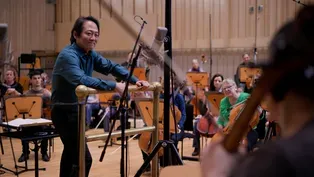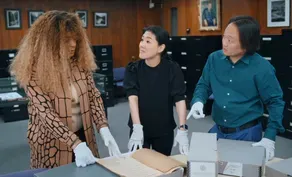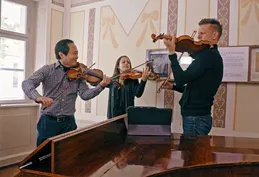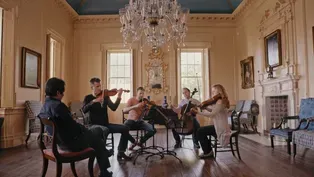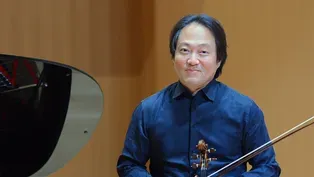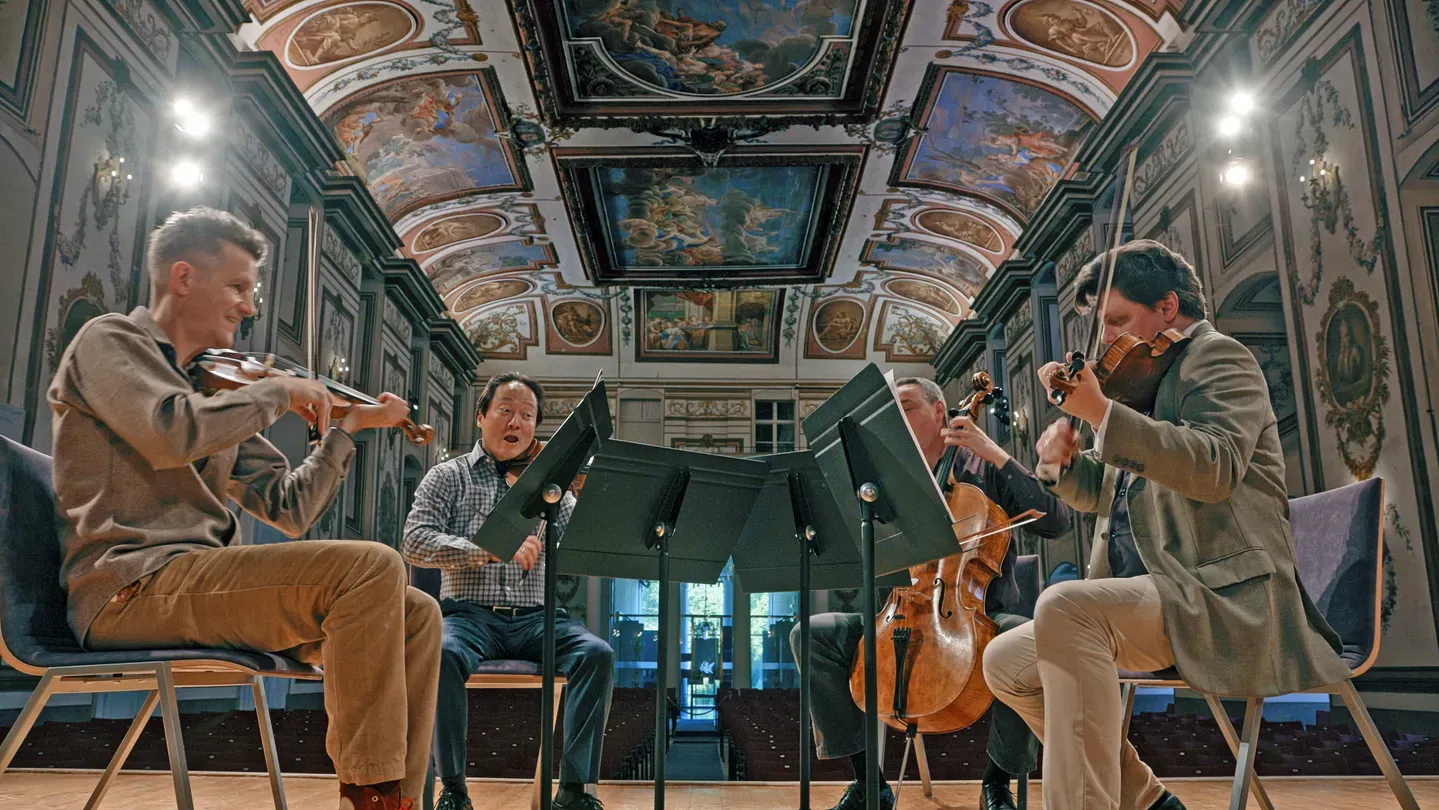

Now Hear This “Haydn: King of Strings”
Season 48 Episode 2 | 53m 37sVideo has Closed Captions
Explore the work of famed composer Joseph Haydn’s career with host Scott Yoo and guests.
Explore the work of famed composer Joseph Haydn’s career with host Scott Yoo and featured guest artists as he discovers how Haydn borrowed folk music from Scotland, Hungary and Austria to create his famous “Emperor Quartet.”
Problems with Closed Captions? Closed Captioning Feedback
Problems with Closed Captions? Closed Captioning Feedback
Major series funding for GREAT PERFORMANCES is provided by The Joseph & Robert Cornell Memorial Foundation, the Anna-Maria and Stephen Kellen Arts Fund, the LuEsther T. Mertz Charitable Trust, Sue...

Now Hear This “Haydn: King of Strings”
Season 48 Episode 2 | 53m 37sVideo has Closed Captions
Explore the work of famed composer Joseph Haydn’s career with host Scott Yoo and featured guest artists as he discovers how Haydn borrowed folk music from Scotland, Hungary and Austria to create his famous “Emperor Quartet.”
Problems with Closed Captions? Closed Captioning Feedback
How to Watch Great Performances
Great Performances is available to stream on pbs.org and the free PBS App, available on iPhone, Apple TV, Android TV, Android smartphones, Amazon Fire TV, Amazon Fire Tablet, Roku, Samsung Smart TV, and Vizio.
Buy Now
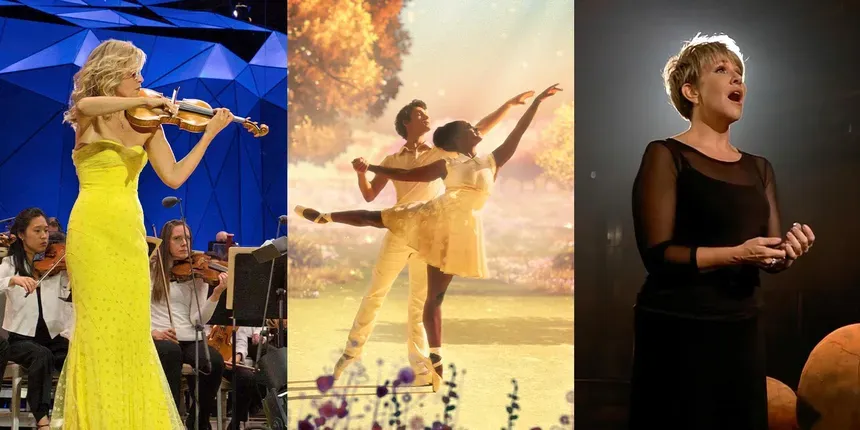
Great Performances Newsletter
Subscribe to the Great Performances newsletter to keep up with the latest full episodes to stream, exclusive content, and more!Providing Support for PBS.org
Learn Moreabout PBS online sponsorshipMore from This Collection
Now Hear This "Rachmaninoff Reborn"
Video has Closed Captions
Discover Rachmaninoff's reinvention as an American artist after losing everything in Russia. (54m 23s)
Now Hear This "Boccherini: Night Music"
Video has Closed Captions
Explore Boccherini’s love for Madrid through a musical night tour of the city with Scott Yoo. (53m 54s)
Now Hear This “Chopin’s Polish Heart”
Video has Closed Captions
Explore Chopin’s musical evolution from Poland to Paris with Scott Yoo and pianist Jan Lisiecki. (53m 54s)
Now Hear This “The Composer is Yoo”
Video has Closed Captions
Follow host Scott Yoo’s journey to compose a piece of music for the first time. (54m 24s)
Video has Closed Captions
Explore how virtuosos become maestros, featuring Yo-Yo Ma, Lynn Chang and more. (53m 54s)
Video has Closed Captions
Explore the work of two legendary virtuosos, Niccolò Paganini and Robert Johnson. (53m 24s)
Video has Closed Captions
Visit Julliard Pre-College with Scott Yoo to play with some of tomorrow’s virtuosos. (53m 54s)
Now Hear This “Albéniz: Portraits of Spain”
Video has Closed Captions
Discover the inspirations Spain provided composer Isaac Albéniz with host Scott Yoo. (54m 25s)
Now Hear This “Andy Akiho Found (his) Sound”
Video has Closed Captions
Experience the creation of music from this Japanese American composer with host Scott Yoo. (53m 34s)
Now Hear This “Schumann: Genius and Madness”
Video has Closed Captions
Visit Scotland, Germany and France with host Scott Yoo. (53m 25s)
Now Hear This “Piazzolla’s History with Tango”
Video has Closed Captions
Tango to Buenos Aires, Argentina, with host Scott Yoo. (53m 55s)
Now Hear This "Florence Price and the American Migration"
Video has Closed Captions
Host Scott Yoo follows the trail of the great African American composer Florence Price. (54m 25s)
Providing Support for PBS.org
Learn Moreabout PBS online sponsorship♪♪ ♪♪ -Next, on "Great Performances" -- I'm Scott Yoo.
Come with me across Austria and Hungary, to London and Charleston, South Carolina, with Geoff Nuttall, one of today's experts on the first classical composer, Joseph Haydn.
-Haydn is the man, and I'm so lucky to try to share the genius of Haydn with everyone around the world.
-Together, we'll uncover how a country boy from a tiny Hungarian village became one of the most influential composers in history.
♪♪ -He was the first guy to do this.
-It's hard to imagine how mind-blowing that would have been.
Haydn did everything first and better.
-[ Laughs ] His music is a real melting pot of different cultures.
We'll see how Haydn used folk music and his life experiences to create a new musical genre.
I've never heard the bagpipes sound so good.
-I'm just imagining Haydn sitting there, writing.
"I know, bagpipes!"
[ Laughter ] -It's time.
I think we should play some Joseph Haydn.
-Coming up, the king of strings.
A new episode from the music series "Now Hear This."
[ Playing final flourish ] [ Playing classical music ] ♪♪ -The string quartet.
It's just a violin, a viola, another violin, and a cello.
Or in this case, since I don't play the cello, another viola.
♪♪ But when the composer does it right, these four similar instruments can work magic.
♪♪ It's more than music.
It's a perfect collaboration.
All instruments are independent, yet all are one.
♪♪ But this magic does not come easy.
Creating a universe of interplay with just these four similar instruments is such a challenge that it has become the proving ground for composers.
♪♪ And it all began with Joseph Haydn.
In the mid-1700s, first he created the string quartet.
Then, he wrote 68 of them.
♪♪ I was out to discover how Haydn became the king of strings.
♪♪ ♪♪ And the person to go to was Geoff Nuttall, violinist and Director of Chamber Music at the Spoleto Festival in Charleston, South Carolina.
Wow, that's beautiful too.
-Yeah, amazing.
-No one loves Haydn more than Geoff.
-I'm often struck by the history here.
I'll be walking to rehearsal and I look at a house, and there's a plaque that says "1772" on it.
And I think, "Haydn was at Esterházy and he was finishing up the Opus 20 quartets, changing the course of music history.
So it's one of the few places in North America that has a direct link, historically speaking, to what was going on in Europe.
The string quartet is my life, and if you're in a string quartet, Haydn is the man.
And I'm so lucky to play and record and try to share the genius of Haydn with everyone around the world.
-It's a life well-lived.
-Well, I think so, and I'm convinced Haydn, I mean, if you met him, hung out with him, he would be so imaginative, so quirky, so witty, so meaningful as a human, and it really comes out in his music unlike any composer that I know.
And I was thinking it would be incredible if we could go and play some Haydn in a house that was built in the 1760s, and was actually used in the Revolutionary War as the British headquarters.
It would be really cool to play some Haydn there.
-Let's go.
-Let's go.
-Geoff's main job is first violinist of the St. Lawrence String Quartet, some of the leading experts in the quartet works of Haydn.
They would help me understand how he developed the form.
I'm struggling to think of another human system where you have four people working so intimately with each other and all four are equals.
I mean, I guess maybe there are people who are coding for "Minecraft" or something and maybe they are.
[ Laughter ] But if you really think about something like a string quartet, which is essentially one organism with four cerebrums and 16 strings.
-It needs to be a single organism.
It needs to be this blending of the four minds, and yet the minds still have to have a little bit of their own personality.
Or maybe a lot of their own personality.
-But I think it's interesting because the idea of the quartet was this democracy, this sort of four voices speaking amongst themselves.
Sometimes friendly, sometimes contentious, sometimes argumentative.
But the bottom line, and why we love to play and hopefully why audiences love to listen, is the fact that it's this connected emotional journey.
-Sure.
-Haydn wrote 68 quartets.
At least 55 of them are total masterpieces.
And of course we can't play them all.
So we were talking amongst ourselves like, "Which quartet, if you had to pick one?"
Which is really hard.
You know, if you had 55 children and you had to pick one.
But, you know, "Which quartet would sum up the genius of Haydn as well or better than any of the others?"
And we came up with one of the late Opus 76 quartets, the "Emperor."
So we have the four-movement structure that he created early on, and it stayed with the quartets into Beethoven and Mozart and everyone that followed.
First movement, storytelling.
It's a simple story.
Then, the song.
Beautiful song, "Kaiserlied" in this case.
Dance, third movement, the minuet.
And then the final movement is a party.
Incredible energy, in this case starting dark and ending jubilant.
So it's really, I mean, this first movement is one of his great stories.
-Love to hear it.
♪♪ ♪♪ ♪♪ ♪♪ ♪♪ ♪♪ -Here in Charleston with the St. Lawrence Quartet, and in Austria and Hungary, Haydn's old stomping grounds, I'd go with Geoff to learn the story of the "Emperor Quartet," and through it, the story of Haydn's creation of this genre of music.
♪♪ But first, I was off to get a little background.
When Haydn was 60 years old, he went to London.
It was the first time in his life he traveled more than 50 miles from where he was born, outside Vienna.
♪♪ For the first time, he heard some English music that would later inspire his "Emperor Quartet."
I talked to cellist Alasdair Tait and baritone Theo Platt.
[ Quartet ends ] Alasdair, we're in London.
-We're in London, possibly very close to the area Haydn would've arrived, in, I think, 1791.
-What kind of music to you think he heard when he was here?
-I think a lot of folk music.
I mean, good old English folk melodies.
For example, "God Save the King," as it was then, which he would've heard for the first time when he came here.
Even then, no one really knows the origins of that, so... -It's indigenous music.
-It's music of the people.
And it was a simple melody.
It was something that they could all just get into their heads without too many problems.
And allowed them to then put these words that showed real support and real connection with their country and the figurehead, the monarch.
-That's right.
-And I think it's particularly exciting, and it would've been for Haydn to have seen, well, look, something so simple, even mundane possibly, can be transformed into this imperial, rousing, grand anthem.
♪ God save our gracious Queen ♪ ♪ Long live our noble Queen ♪ ♪ God save the Queen ♪ ♪ Send her victorious ♪ ♪ Happy and glorious ♪ ♪ Long to reign over us ♪ ♪ God save the Queen!
♪ [ Song ends ] -Beautiful.
Nearby, on the banks of the Thames, we met a few of the Royal Scottish Pipers to hear another kind of folk music.
[ Traditional Scottish music playing ] ♪♪ ♪♪ ♪♪ [ Applause ] Bravo.
You guys are amazing.
-Hey, brilliant, great.
-Hi, how are you doing?
-Great.
Thank you for that.
-Incredible.
I've never heard the bagpipes sound so good.
It sounds like one instrument, you guys are so in tune with each other.
-Thank you very much.
-Fabulous.
So how do you play one of these things?
-Well, it's quite straightforward.
First of all, they're controlled by four reeds.
Three, and one in each of these drones, that's what these are called, drones.
-Okay.
-And they've got to be harmonized with the chanter, which is what we play on.
And there's a small cane reed in there.
I'll show you.
-Oh.
-Oh, it looks like a... -Okay.
So that's where it... -Oh, wow.
-So the air -- it gives that really pushing the air between these two.
-That's it.
That's basically what it is.
-Very, very cool.
-You know, hearing the drones, do you remember in the "Emperor Quartet," in the first movement, that drone section?
The cello comes in, it's got that... [ Droning noise ] -Could've come from here.
-I wonder if this is exactly what he heard.
Heard that, took the folk influence back to Austria, suddenly there it is in the middle of one of the iconic quartets.
What do you think?
-And I wonder -- That's what this is called.
This is called a drone.
-A drone, absolutely.
♪♪ Actually, you know, I've been trying for years to make a sound like that, and I've never succeeded.
We actually need a bagpipe in the quartet, I think.
-Well, this is the real thing.
This is straight from the source.
-It's straight from the horse's mouth.
Brilliant, thank you.
-Would you all be willing to try that drone theme of the Haydn "Emperor Quartet"?
-Sure.
-Yeah.
-Okay!
All right.
[ Low drone intro ] [ Bagpipes playing ] ♪♪ ♪♪ ♪♪ ♪♪ ♪♪ ♪♪ ♪♪ [ Tempo slows ] ♪♪ [ Playing flourish ] -I'm just imagining Haydn sitting there writing, "I know, bagpipes!"
[ Laughter ] -When in doubt, choose the bagpipes.
[ Laughter ] [ Indistinct conversation ] -In rural Austria, Geoff took me, violist Charlotte Bonneton, and cellist Marcell Vamos to a critical place in the formation of the string quartet.
-It's incredibly exciting to be here for me, at most probably the place where Haydn created the idea of the string quartet.
We're in Weinzierl, is -- -Yeah, Weinzierl.
-Yeah, much better.
In rural Austria.
And Haydn as a teenager came here for a couple of summers.
And most probably, it was by pure chance the quartet emerged.
He played the violin.
He had some buddies, another violinist, a violist, and a cellist, and he was asked to provide some music for parties, background music.
And he used these combination of instruments that he had to provide the music.
And it wasn't as if there weren't pieces written for these four voices -- soprano, alto, tenor, bass -- came from the choir.
There are examples beginning with late Baroque music, Alessandro Scarlatti, Allegri.
And it all sort of connected to the Baroque traditions of the trio sonata.
Two soprano lines and a bass -- -We played those in Italy.
Handel, Corelli.
-The predominant form of chamber music in the day.
And so that's where Haydn was coming from.
But the addition of the viola, of course, being the crucial ingredient.
-Always the viola.
[ Laughter ] -And the idea that what became -- I mean, again, totally biased opinion -- the greatest musical form ever, perhaps was stumbled upon by Haydn as a teenager here because he needed to supply background music for these parties.
But I think it's safe to say he quickly realized that, "Hey, this is something I can take and express myself better than any other form."
And I just love the fact that we're at ground zero of the string quartet as we know it.
-Wow.
♪♪ ♪♪ Alessandro Scarlatti, the same guy who inspired Handel, was here again.
He may not have developed the string quartet as a form, but it seems he was the first to write for just these four instruments.
♪♪ ♪♪ [ Classical piece ends ] -Well, there you go.
What do you think?
-Sounds like baroque music to me.
-Very baroque.
-Baroque dance music, totally.
-You can feel -- yeah.
I just love that moment, that we were possibly playing the first example of a string quartet, even though it's a long way from what Haydn would take it and turn it into.
-Hmm.
-Okay, it's time.
I think we should play some Joseph Haydn.
This is one of his most groundbreaking and revolutionary examples, the first movement of Opus 20 number 2.
♪♪ ♪♪ ♪♪ ♪♪ ♪♪ -Though the six quartets of Opus 20 are fairly early in Haydn's quartet writing career, these were his breakthrough, establishing the brilliant collaboration that he would perfect in later quartets.
♪♪ ♪♪ ♪♪ ♪♪ It's amazing to think that if Haydn hadn't come here and been forced to work with these four instruments, to create a complete work with just these four instruments, this entire genre of music might not exist.
♪♪ ♪♪ ♪♪ ♪♪ [ Classical piece ends ] -Oh, my God, he's so good.
-Yeah.
-Isn't that incredible, though?
I mean, it's hard to imagine how mind-blowing that would've been.
The cello starts alone with the tune!
And what's the viola doing?
-Playing the cello part.
-Playing the cello part.
And within, like, three lines he switched the roles and I'm playing the bass, and you're playing solo, and you're playing the... it's crazy!
I mean, it doesn't seem that way to us now.
We've been tainted through centuries of listening to other musics, but it would've been so mind-blowing.
-But he was the first guy to do this.
-I mean, without -- This set of Opus 20 totally changed the game.
It was so groundbreaking.
It inspired everyone from Mozart and Beethoven through the next century.
But it was all about this democracy in action.
It's just, it's remarkable on so many levels.
And it set in stone the idea that the string quartet could be this form of expression unlike any other.
So props to you, Papa Joe.
Amazing.
-So we're going to be playing the second movement of this quartet.
It's the reason it's called the "Emperor Quartet," and that's because this tune, the "Kaiserlied," is a melody that Haydn composed after he went to London where he heard "God Save the King."
And Haydn thought to himself, "Austria doesn't have one of these.
My emperor needs an anthem."
So he went back to Austria and took it upon himself to write the Austrian National Anthem.
And it's why it has the nickname the "Emperor."
Unfortunately, it's become associated with other periods of history.
It was co-opted by the Nazis.
But for the last 200 years, and hopefully the next 200 or more, it'll have this association as Haydn's greatest melody.
-It was supposedly also his favorite melody.
After Haydn composed it for the "Kaiserlied" -- literally the "Emperor's Song" -- he used it in the second movement of the "Emperor Quartet."
Geoff took us to the place where he wrote it.
-Here we are.
-The house!
-Incredible.
Haydn's last house that he purchased -- Well, his wife actually purchased it in the 1790s.
But if you can imagine, this would've been rural, suburban Vienna, and now it's all built up.
-Now it's changed.
-The house itself is as it was.
Upstairs was Haydn's last resting place and his music room.
This is an amazing moment for me.
You guys want to check it out?
-Yes.
-Let's do it.
This is Haydn's last keyboard, fortepiano... -[ Laughs ] -...that he played on every day.
And I've been dreaming of this moment for so long.
It's just an amazing thing to be here, because you can almost feel him.
Supposedly every day he would come and play.
He would play his "Kaiserlied," which became of course the Austrian National Anthem, but the vision of him sitting here, the old guy humming away, singing along probably, even such that the last day of his life, supposedly, carried him up here.
He sat down at the keyboard, played his "Kaiserlied" a couple times, and then got sick and he died later that day.
So it gives me -- The hairs stand up on the back of my neck.
And this -- another dream.
Can we play?
-Let's do it.
♪♪ ♪♪ ♪♪ ♪♪ ♪♪ ♪♪ ♪♪ ♪♪ ♪♪ [ "Kaiserlied" ends ] -Wow.
That was one of the cooler moments of my musical life.
-Yes.
-[ Laughs ] -I just... [ Sniffles ] You understand why he was so attached to that melody?
And so proud.
I mean, it's -- it's this incredible amalgam of almost religious devotion to his country and his emperor, but with this human heart that...
The intervals of the... [ Singing ] the reach up for that, it gets me every time.
Unfortunately, like a lot of other things they touched, the Nazis just destroyed its legacy.
Because now it's associated with Germany and the Second World War.
Haydn, I think, would be horrified and devastated by what unfortunate associations have come to his magnificent "Kaiserlied."
But it's one of the great stories in the history of music, and to be doing it here is just... -Very cool.
-Incredible.
-I'll never forget this amazing moment.
♪♪ -Haydn may have spent his last years in Vienna, but he was born in a farmhouse in the tiny village of Rohrau, in what is now Austria, near the border with Slovakia.
His parents were folk musicians, and from these humble beginnings, both their sons, Michael and Joseph, became great composers.
[ Folk music playing ] ♪♪ We were here to listen to a kolo band play some of the folk music of the area.
♪♪ ♪♪ -Ja.
-Bravo.
-Whoo!
[ Applause ] ♪♪ -[ Singing in foreign language ] -Wait a minute, that's the "Kaiserlied" melody!
[ Singing continues ] ♪♪ ♪♪ ♪♪ [ Continues in foreign language ] ♪♪ [ Song ends ] -He stole it.
[ Laughs ] Michael, what was that?
That was folk music?
-Yes.
It was a Croatian folk music from this territory.
-So this region was Croatian in Haydn's day, you think?
-You know, this was Esterházy family, and the Esterházy family had Croatian workers, and I think Haydn heard this song.
-He must've heard that as a kid?
Or it was in the air, in the water here in this region of Austria, or Hungary?
But it's a Croatian folk tune that morphed into the "Kaiserlied" and then became the German National Anthem?
-I thought that Brahms was the first guy to take folk music and integrate it, but no.
-No.
-Much earlier.
-Basically, Haydn did everything first, and better.
-[ Laughs ] ♪♪ ♪♪ ♪♪ ♪♪ ♪♪ ♪♪ [ Tempo slows ] ♪♪ -The next day, I went across town to meet the quartet again in another of Charleston's historic 18th century mansions, this one now a girl's school.
♪♪ Leslie, what is the third movement of a Haydn quartet?
-In every single case, the third movement is a minuet.
In every one of Haydn's string quartets, his symphonies.
And after him, everybody followed this theme.
-So the minuet itself is the dance, but it's the context of where it is in this piece in this journey.
Remembering that everyone in Europe, especially where he was working from 1760 on, say, was very comfortable dancing the minuet.
So the steps, it was part of who they were, not only as musicians, but as just human beings -- dancing the minuet.
I think it's hard for us to get a grip over what a parallel situation would be in our -- -Well, when you listen to pop music, you've never heard it before, but you know how it goes, right?
-Right.
There's something like that.
You just -- -It's probably similar.
-Remember our connection to folk music.
The minuet was a country dance, a folk dance.
And he basically single-handedly took it and made it part of the symphony and the string quartet.
Made it into "drawing room music," so to speak.
-Let's hear some.
♪♪ ♪♪ ♪♪ ♪♪ You can really hear Haydn's folk influence in this music, too, and the swinging "one, two, three, one, two, three, one, two, three' rhythm of the country dance.
♪♪ ♪♪ He would've written both dance and drawing room music while working for the Esterházy family, and his employment here shaped his great productivity.
We met with Dr. Florian Bayer, an Esterházy historian.
-So this is the famous castle of Esterházy here in Eisenstadt.
-It's incredible.
-Joseph Haydn used to live many years here.
He started in 1761, and he worked for more than 40 years for the Esterházy family.
He started as a deputy conductor in the court, but he found already an orchestra here with some musicians.
So the first main advantage he had, he arrived in a place finding an orchestra, and he just could start to compose.
-Oh, my God.
I mean, what an advantage, to have your own orchestra, probably his own musicians for chamber music, for string quartets.
It's like an R&D Department.
-Yeah.
-His own R&D Department.
-With an endless budget.
-So are some of the instruments in Haydn's orchestra still here?
-Yeah, we are lucky, there are still some instruments that have survived, and just follow me, I will show you.
-Oh, great.
This must be a really nice place to work.
-It is.
-You come here every day?
-Yes.
-How does it get better than that, right?
-So here I have two bows for each of you.
-Oh, thank you.
-Thank you.
-And here are two extraordinary instruments from our collection.
You still see the wax seal here.
That indicates the origin of this piece.
-So this stamp would've meant -- it was like a brand?
So all the orchestra instruments... -Were branded so that no one could take them away.
And Haydn was, as the director of the court orchestra, he was responsible also for the instruments, not only for the musicians.
So if anything should have happened... -It was his responsibility.
-It was his responsibility.
-But do you think he actually would maintain them and fix them?
-Yes.
He was the one to take them away after the rehearsals and put them... -Really?
-...into a storage room... -Wow.
-And getting it out again.
-That's really -- -I mean, he was amazing.
He did everything, right?
-Yeah.
-I mean, it's incredible.
But the fact that -- I mean, what blows me away is that this instrument was possibly played in this room by Haydn in 1762 or something like that.
Very possibly, right?
-Yeah, that's possible.
-So his chin -- I can see a little bit of Haydn chin there.
Isn't that amazing?
-[ Laughs ] ♪♪ -Wow.
♪♪ [ Plays bum note ] -Ooh, it's a little out of tune.
-Here's a little bit of Haydn.
♪♪ -So that's the first time that this violin has been played for many, many years.
-What an honor, thank you.
♪♪ -As director, Haydn had to provide music for everything here, which would have included dances.
And for that, he's known to have hired local folk musicians.
♪♪ ♪♪ This gypsy band, fronted by the great Hungarian violinist Gabor Homoky, is playing in the same courtyard where these dances were sometimes held.
♪♪ ♪♪ ♪♪ ♪♪ -Whoo!
♪♪ ♪♪ ♪♪ [ Piece ends ] -Whoo!
-[ Vocalizes ] -Bravo.
Bravo.
-That's authentic gypsy music?
-Yeah, it is.
-That is the real thing?
-Yeah, it is authentic gypsy music from that period when Haydn lived.
-Really?
-Yes.
-So this is gypsy music but from Haydn's time?
-Yeah, it's Hungarian gypsy music, exactly, yes.
-No kidding.
-And Haydn heard this.
-Really?
-Yes.
Haydn heard this music?
-I think.
-Something similar.
-Something similar.
You know, the place where we are now, this palace.
You see, there's written Kismarton.
-Oh, yeah I see it.
Kismarton.
-It's Eisenstadt in Hungarian, because this was Hungary before.
And you know this area, here lived many Croatians, Hungarians, also German speaking people.
So also in this music you can hear these things.
-So this music is a real melting pot of different cultures.
-Yeah, it is.
It is, of course.
♪♪ -Halfway through Haydn's employment with the Esterházys, they built a spectacular new palace in what is today Western Hungary, inspired by Versailles.
♪♪ Here, they held more elaborate court dances.
And Haydn created music for these, too.
♪♪ -Uh-huh.
-Well, here we are -- the Esterházy palace, where Haydn would've moved with the Esterházy family in the late 1760s and taken on his duties as court composer.
Remembering through all this that he was a servant to the Esterházy family.
Amazingly, he was expected to every once in a while, to "Come and serve our guests, you know, pour wine for our guests," Haydn, and then go back to writing some more symphonies.
So the idea of Haydn as this incredible genius, this amazing figure, but a servant for most of his life.
-Wow.
It makes you wonder if that's why he designed the string quartet as four equal people without a hierarchy.
I mean, of course the first violin, you know, you, you're the first among equals.
But still, the string quartet is four voices and everybody counts, everybody matters.
-That's an interesting theory.
Democracy in action not only in life but in music as well.
I always say, if you want to really discover the genius of Haydn in the shortest period of time, take at random four minuets from any one of the quartets after Opus 20, and within the very strict requirements he created, he was effortless in his genius, in his imagination.
The fact that he used that and turned that dance form into part of the string quartet and the genre of the string quartet is pretty cool.
-Mm-hmm.
-Want to go play some dance music in the dance hall?
-Yeah, let's do that.
There's a dance hall up there?
-Well, on the second floor, yeah.
-Cool, let's do it.
-So, this is the minuet "alla zingarese."
Here's sort of a traditional, danceable version of this minuet.
♪♪ ♪♪ -Charming, lovely, graceful, danceable.
Here's, simply by adding accents in the wrong spot, you can almost picture the dancers tumbling to the floor.
-Geoff, do you know why is it written like this?
-What do you think, Gabor?
-Yeah, it's because Hungarian music is always in 2.
And you know gypsy musicians are actually playing always here in Hungary.
So, he heard that one from the gypsies somehow and then that's why he wrote... [ Counts rhythm ] because Hungarian music is always like this.
That's a joke of Haydn.
-And then the trio, the contrasting middle section, couldn't be more perfectly in three.
The raised pinky finger on your teacup.
The juxtaposition within a three-minute movement of these two elements is the real joke in this movement.
So here we have it, "alla zingarese," Opus 20, number 4.
♪♪ ♪♪ ♪♪ ♪♪ ♪♪ ♪♪ -To keep his listeners, and probably himself, entertained, Haydn liked to surprise them with the unexpected.
And this too became part of the string quartet format.
♪♪ ♪♪ ♪♪ ♪♪ ♪♪ [ Quartet ends ] ♪♪ When Haydn returned from London, he went back to work for the Esterházys in Eisenstadt.
We went back, too, to play in the space they named for him, the famous Haydn Hall.
♪♪ ♪♪ ♪♪ ♪♪ ♪♪ There's probably no better work to showcase Haydn's sense of humor than this quartet nicknamed "The Joke."
And the joke for the audience is knowing when it ends.
[ Quartet continues ] ♪♪ [ Quarter continues ] ♪♪ [ Quarter continues ] ♪♪ [ Quarter continues ] ♪♪ ♪♪ ♪♪ ♪♪ -[ Chuckles ] It's -- it's such a -- I mean, it's so tremendous on so many levels, and it's an effortless display of humor in music.
And it's just this incredible combination -- It's not just slap-your-knee, guffaw laughter humor.
It's false expectation, confusion.
It's hilarious on so many levels, but it's complicated in the best possible sense of the word.
-It's a game.
Who will know when it's over?
-Yeah, totally true.
And then the end is the beginning.
And this inspired Mozart to do some of his greatest work.
And the friendship that they had is so special, even though they were 19 years apart, a much younger man.
But the fact that Mozart loved and respected Haydn and his music so much is a real testament to Haydn's genius.
And the set of quartets that was Mozart's response to Haydn's Opus 33 are the six Haydn quartets that Mozart wrote and dedicated to Papa Haydn.
And you can really hear him being inspired, emulating even, the quartets of Haydn in these works.
You want to play a little Mozart now?
-Sure.
-Why don't you take first on this one?
-Okay, sure.
-Some great licks.
♪♪ ♪♪ -Haydn's quartets inspired Mozart to write them, then Beethoven to show he could take the format in a new direction.
Then Schubert, who admired what Beethoven had done.
And so on, all the way to the great quartets of Bartok in the 20th century.
But it all began with Haydn.
♪♪ ♪♪ ♪♪ ♪♪ ♪♪ ♪♪ ♪♪ ♪♪ ♪♪ ♪♪ [ Bell tolling ] As our last stop in Austria, we went to a restaurant on a hill above Eisenstadt to talk about what we'd learned.
I'm surprised that Haydn was so influenced by folk music.
-It's interesting.
I mean, I always thought and give him credit as being, especially with the Opus 20 quartets, that he took folk music from the country and made it part of the drawing room, made it part of music moving forward.
But what blew me away was hearing that Croatian folk tune, which is eerily similar to the "Kaiserlied," which of course is the slow movement of the "Emperor Quartet," so, I mean, whether he stole it exactly, or whether as a kid it was just embedded in his memory... -But we know that the Croatian folk song existed before the Kaiser Quartet, right?
-That's what we discovered.
-You know that?
I don't believe it.
-You don't believe it?
-No, I think this Croatian song was after Haydn.
-Really?
-I think the Croatian people here -- because here in that area there lived Hungarians, Croatians, Germans, they all -- it was a mixed culture -- and they heard what Haydn composed.
So I think they borrowed the music.
You know, Ernest, we also played today this czardas.
There's also that part where it is a German folk song, almost.
-I find it very possible.
-So everybody's stealing from everybody, basically.
-It's a great tune either way.
It doesn't really matter.
You know, it doesn't lessen the brilliance of the "Kaiserlied," I think it's safe to say.
-Yeah, I think everybody loves good music, and that's why.
-Right.
♪♪ ♪♪ -Bravo.
-Bravos.
Thanks.
-Excellent.
-So you know the "Auld Lang Syne" song?
-You mean what we sing at New Year's?
-Yeah, it's very old Scottish folk music.
-Okay.
-And you know Haydn arranged it to classical music.
-Haydn arranged "Auld Lang Syne" to make it a classical piece?
-Yeah.
-I did not know that.
-And now we will try to do it, the original one, and then in a different way.
-Really?
Who's going to sing?
-I will sing.
-Really?
-Yes, I try.
-Excellent!
-Thank you.
-Okay.
♪♪ ♪♪ [ Playing "Auld Lang Syne" melody ] ♪♪ ♪♪ ♪♪ Haydn took this old Scottish folk tune, orchestrated it for classical instruments, and helped it become an anthem of its own -- one that's been performed by great musicians of later eras, like Elvis, who themselves borrowed folk music in search of melodies that could cross cultures and time.
♪♪ ♪ Where old acquaintance be forgot ♪ ♪ And never brought to mind?
♪ ♪♪ ♪ Where old acquaintance be forgot ♪ ♪ And auld lang syne ♪ ♪♪ ♪ We're auld lang syne, my dear ♪ ♪ We're auld lang syne ♪ ♪ We'll take a cup of kindness, yeah ♪ ♪ For auld lang syne ♪ [ Playing bluesy solo ] ♪♪ ♪♪ ♪♪ ♪♪ ♪ We'll take a cup of kindness yet ♪ ♪ For auld lang syne ♪ ♪♪ [ Song ends ] ♪♪ -Before I left the Spoleto Festival, Geoff and his group were playing the "Emperor Quartet."
♪♪ ♪♪ In this last movement, you can hear everything that Haydn introduced to the format -- folk music and the country dance, unexpected turns that surprise the listener, and of course, democracy in action, every instrument conversing as equals.
♪♪ ♪♪ ♪♪ [ Tempo increases ] ♪♪ ♪♪ ♪♪ ♪♪ All these signature elements, which sprang from Haydn's personality and personal experiences, have been passed down through all the string quartets after him.
When you hear any quartet, you're hearing Haydn.
And if that's not influential enough, when Haydn was creating the string quartet, he also invented the symphony, then wrote 104 of them.
Haydn truly was the king of strings.
♪♪ I'm Scott Yoo, and I hope you can "Now Hear This."
♪♪ ♪♪ [ Cheers and applause ] -To find out more about this and other "Great Performances" programs, visit pbs.org/greatperformances, find us on Facebook, and follow us on Twitter.
Haydn: King of Strings Preview
Video has Closed Captions
Preview: S48 Ep2 | 30s | Explore the work of famed composer Joseph Haydn’s career with host Scott Yoo and guests. (30s)
Video has Closed Captions
Clip: S48 Ep2 | 1m 48s | Geoff Nuttal and the St. Lawrence Quartet play Haydn's classic Emperor Quartet for Scott. (1m 48s)
Scott Yoo Performs Beethoven's Kreutzer Sonata
Video has Closed Captions
Clip: S48 Ep2 | 3m 51s | Scott Yoo, host of "Now Hear This," performs an excerpt from Beethoven's Kreutzer Sonata. (3m 51s)
Providing Support for PBS.org
Learn Moreabout PBS online sponsorshipSupport for PBS provided by:
Major series funding for GREAT PERFORMANCES is provided by The Joseph & Robert Cornell Memorial Foundation, the Anna-Maria and Stephen Kellen Arts Fund, the LuEsther T. Mertz Charitable Trust, Sue...
